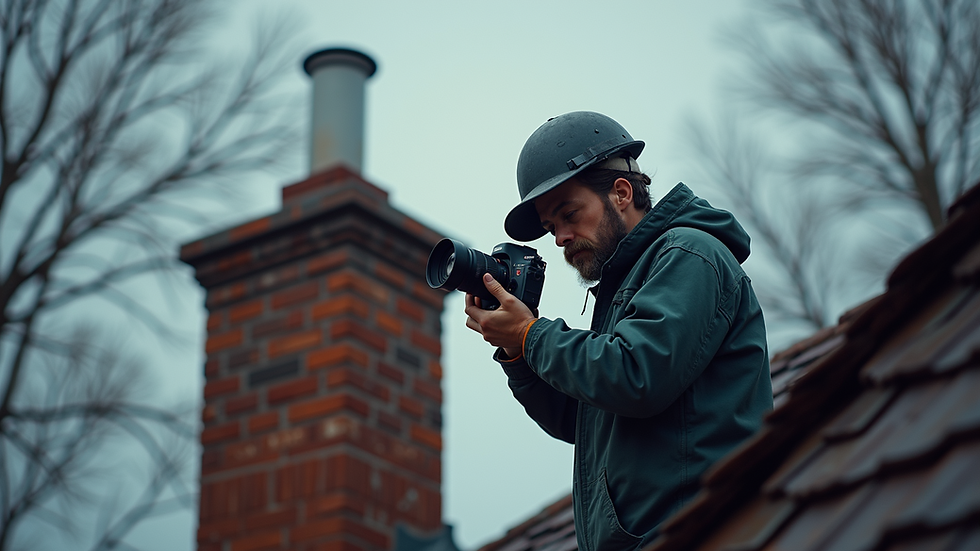Innovative Chimney Cleaning Solutions
- Laura Lawlor

- 12 minutes ago
- 4 min read
Keeping your chimney clean is essential for maintaining a safe and efficient fireplace. Over time, soot, creosote, and debris accumulate inside the chimney, posing fire hazards and reducing airflow. Fortunately, there are innovative chimney cleaning approaches that make this task easier, safer, and more effective than ever before. This article explores modern methods, tools, and tips to help you maintain your chimney with confidence.
Modern Chimney Cleaning Approaches: Tools and Techniques
Traditional chimney cleaning often involved manual brushing and sweeping, which could be labor-intensive and messy. Today, several innovative approaches have transformed the process:
Rotary Cleaning Systems: These use motorized brushes attached to flexible rods. The rotating action scrubs the chimney walls thoroughly, removing stubborn creosote and soot layers. This method is faster and more efficient than manual brushing.
Vacuum-Assisted Cleaning: Specialized vacuums designed for chimney cleaning capture dust and debris during the cleaning process. This reduces mess inside the home and improves air quality.
Video Inspection Cameras: Before and after cleaning, professionals use small cameras to inspect the chimney interior. This helps identify blockages, cracks, or damage that need repair.
Chemical Creosote Removers: Some products can be applied to the chimney to soften creosote deposits, making them easier to remove during cleaning.
These approaches not only improve cleaning quality but also enhance safety by reducing the risk of chimney fires and carbon monoxide leaks.

Choosing the Right Chimney Cleaning Approaches for Your Home
Selecting the best chimney cleaning approach depends on several factors:
Type of Chimney: Masonry chimneys and metal flues may require different cleaning tools and techniques.
Frequency of Use: Heavily used fireplaces accumulate more creosote and need more frequent cleaning.
Type of Fuel: Wood-burning fireplaces produce more creosote than gas or pellet stoves.
Accessibility: Some chimneys are easier to access from the roof, while others require cleaning from inside the home.
For homeowners who want a hassle-free experience, hiring professionals who use advanced tools like rotary systems and video inspections is recommended. They can tailor the cleaning approach to your chimney’s specific needs.
If you want to learn more about professional chimney cleaning solutions, including services and pricing, visiting a trusted provider’s website is a good start.

What dissolves creosote in a chimney?
Creosote is a highly flammable substance that builds up inside chimneys when wood burns incompletely. Removing it is critical to prevent chimney fires. Several substances and methods can dissolve or reduce creosote:
Chemical Creosote Removers: These products contain chemicals that soften hardened creosote deposits. They are usually applied as powders or liquids and can be used before or after mechanical cleaning.
Potassium Hydroxide (KOH): This strong alkaline solution is sometimes used by professionals to break down creosote layers.
Natural Remedies: Some homeowners use baking soda or vinegar as mild creosote reducers, but these are less effective for heavy buildup.
Heat Treatment: Burning a hot fire at high temperatures can help reduce creosote accumulation over time.
It is important to follow manufacturer instructions and safety guidelines when using chemical removers. Combining chemical treatments with mechanical cleaning ensures the best results.

DIY vs. Professional Chimney Cleaning: Pros and Cons
Many homeowners consider cleaning their chimneys themselves to save money. While DIY cleaning is possible, it has pros and cons:
DIY Pros:
Cost savings on labor
Flexibility to clean on your schedule
Learning experience about your chimney system
DIY Cons:
Risk of incomplete cleaning or damage
Lack of specialized tools like rotary brushes or video cameras
Potential safety hazards from working on roofs or ladders
Difficulty in identifying hidden problems
Professional Cleaning Pros:
Expertise and experience
Use of advanced tools and inspection equipment
Thorough cleaning and safety checks
Insurance coverage in case of accidents
Professional Cleaning Cons:
Higher upfront cost
Need to schedule appointments
For most homeowners, professional chimney cleaning is the safest and most effective choice. However, if you choose to clean your chimney yourself, invest in quality tools and follow detailed instructions carefully.
Maintaining Your Chimney Between Cleanings
Regular maintenance can extend the time between professional cleanings and keep your chimney functioning well:
Burn Dry, Seasoned Wood: Wet or green wood produces more creosote.
Use a Fireplace Screen: This prevents large debris from entering the chimney.
Inspect the Chimney Cap: A good cap keeps out animals, rain, and debris.
Schedule Annual Inspections: Even if you clean yourself, a yearly professional inspection can catch problems early.
Avoid Burning Trash or Treated Wood: These materials produce harmful chemicals and excessive residue.
By following these tips, you can reduce creosote buildup and improve your chimney’s safety and efficiency.
Innovative chimney cleaning approaches have made maintaining your fireplace easier and safer. Whether you choose professional services or DIY methods, understanding the tools and techniques available will help you protect your home and enjoy cozy fires all year round. For trusted and effective chimney cleaning solutions, consider consulting experienced professionals who use the latest technology and methods.




Comments